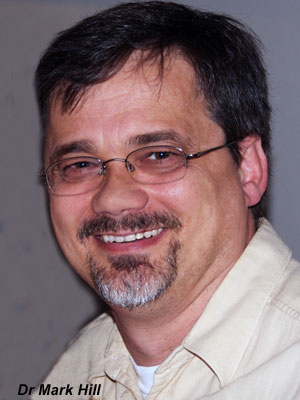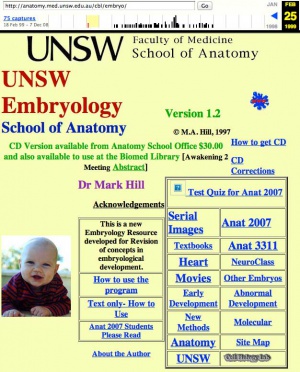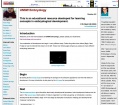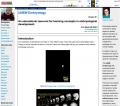UNSW Learning and Teaching Seminar 2012
W3 to W8: W3, Websites, Wikis, Who, What, Where, Why and Wait
Both students and universities have embraced online educational technologies, but knowing that you have a new tool does not always mean that you know exactly how to use it. The seminar will discuss how content and students can be brought together in new and meaningful ways online. The examples I hope to share in the presentation will cover the 16 year development and evolution of UNSW online medical education resources. This presentation and additional information can be found here - http://embryology.med.unsw.edu.au/embryology/index.php?title=UNSW_Learning_and_Teaching_Seminar_2012
Connections in Learning and Teaching
- Date: Tuesday 5th June 1 to 2pm
- Venue: John Goodsell Building room LG19
- Format: 40 minutes presentation and 20 minutes for Q&A and discussion.
Introduction
- I will begin by giving a brief history of the transition to online embryology education.
- Then follow this with examples of the use of online lectures and practicals.
- Then show how students can do peer teaching through online project work.
- Finally a brief discuss self-directed learning through practical class support.
I may not get through all these 4 points, as discussion in this seminar is just as important. Don't worry, this page will remain online and I will add more explanatory text after the seminar has finished. Please feel free to email me if you have any specific questions or comments. --Mark Hill 18:14, 3 June 2012 (EST)
Online UNSW Resources
- Links: ALTC 2011 Citation
Embryology Education
| Technology Timeline | |
|---|---|

The changing technology environment we have experienced in the last 70 years, and more recently in the last 20 "internet years". | |
|
|
1975 - 1995
- Image cross-section "slices" of embryos at 2 key times in early development used to show developing anatomy.
- Prepared by colleagues within the School in association with course note descriptions.
- Canon Microfiche Reader used from 1975 to 1995 to view embryo section 49 images (7x7 matrix) in 3 sets:
- Week 4 Embryo - Stage 13 (2012)
- Week 8 Embryo - Stage 22 (2012)
- Week 8 Embryo - Selected Stage 22 images (2012)
- Separate sets of labelled drawing corresponding to each section, these needed to be swapped each time with sections to view.
- Posters and teaching models (models still used today) to supported this content.
1996
Microfiche images:
- Transferred to an internal network.
- Then to a CDROM.
- Then to the web.
1997 - 1999
- Internet website page established with electronic versions of serial images.
- Medical students volunteered to help with labelling of these embryo sections.
- Class notes were edited for descriptions to accompany each section.
- Added cartoon animations to show how dynamic processes occurred (2012)
- Collaboration with textbook author, so students could compare with textbook images.
2000 - 2007
- 2003 - Innovative Teaching and Educational Technology 4 Fellowship (ITET4) Project on Cell Biology. (2012)
- 2004 - New Medical program, reorganised structure of undergraduate teaching of basic sciences. (Science Magazine)
- 2006 - Medicine Independent Learning Project 3D Embryo Models. (2012)
- 2004 - 2009 - Entirely reorganised practical class structure and presentation to online formats. (2009)
2009 - 2012
New Wiki Format
- familiar structure and layout. (the Wiki format)
- easy to print and search. (print this current page)
- resolved student navigation issues. (every page has the same navigation and access to student pages)
- contributions by researchers staff and students. (Researcher Contributions)
- current research easily added and used by students. (Human development day 3 to 5)
Online Classes
- Both lectures and laboratories in Medicine and Science can be prepared and presented online.
- Online textbooks are directly linked within the classes.
- Additional general notes are available for students to use as topic background.
- An extensive glossary of terms is provided to aid understanding of terminology.
- In development everything changes, even the names of structures!
- Current related clinical and research data, movies and findings can be provided to show relevance of topics.
- Quizzes available to test student knowledge.
- Content can also be modified and used for external education purposes.
Medicine
- Medicine - lectures and practical classes.
Science
- 2011 Course - lectures and practical classes.
Student Online Projects
Medicine - Independent Learning Projects
The Independent Learning Project (ILP) is intended to provide UNSW medical students with a period of in-depth study that engenders an approach to medicine that is constantly questioning and self-critical. (About ILP)
- 2006 - Carnegie Stage Embryo Animations educational project.
- 2009 - Cardiac Embryology educational project.
Science Group Projects
- Earlier group projects in the Science courses had been preparing a poster and a final presentation to the class.
- The online projects also require presentations during their preparation and include a peer assessment process.
- Students also submit individual assessments each week online based upon the practical class they had just completed.
- Listed below are the final group projects (4-5 students/group) submitted between 2009 and 2011 in embryology (ANAT2341) and cell biology (ANAT3231) courses.
Embryology Group Projects
- 2009 - Animal Models: Rabbit | Fly | Zebrafish | Mouse | Project 5 - Frog | Related page - Animal Development
- 2010 - Diagnostic Techniques: Ultrasound | Chorionic villus sampling | Amniocentesis | Percutaneous Umbilical Cord Blood Sampling | Fetal Fibronectin | Maternal serum alpha-fetoprotein | Related page - Prenatal Diagnosis
- 2011 - Abnormalities: Turner Syndrome | DiGeorge Syndrome | Klinefelter's Syndrome | Huntington's Disease | Fragile X Syndrome | Tetralogy of Fallot | Angelman Syndrome | Friedreich's Ataxia | Williams-Beuren Syndrome | Duchenne Muscular Dystrolphy | Cleft Palate and Lip
Cell Biology Group Projects
- 2009 - Cell Topics: Meiosis | Cell Death - Apoptosis | Cell Division | Trk Receptors | The Cell Cycle | Golgi Apparatus | Mitochondria | Cell Death - Necrosis | Nucleus | Cell Shape
- 2010 - Research Techniques: Fluorescent-PCR | RNA Interference | Project- Immunohistochemistry Immunohistochemistry | Cell Culture | Electron Microsopy | Confocal Microscopy | Monoclonal Antibodies | Microarray | Fluorescent Proteins | Somatic Cell Nuclear Transfer
- 2011 - Cell Junctions: Synaptic Junctions | Gap Junctions | Tight Junctions | Desmosomes | Adherens Junctions | Neuromuscular Junction
Online Project support
At the beginning of the course students are led through simple tutorial exercises to become familiar with the process.
- establishing the assessment criteria. (2011)
- text editing and formatting. (Editing Basics formatting references)
- identifying research sources and their reuse. (Images)
- uploading and images, identifying sources and copyright information. (Copyright)
Histology Practical Class Support
Virtual slides was not my work, but developed by many colleagues in Medicine supported by ALTC grant.
Students in both Science and Medicine classes now learn histology and pathology through the use of "virtual slides". In these classes students work through a series of unlabelled slides guided by an academic coordinator and supported by tutors. These slides are projected onto screens and monitors and students own computers to view the slides.
Students can access the slides outside of the class hours and now can also access self-directed learning support from specifically designed online resources.
Virtual Slides
- Developed by colleagues in Medicine supported by ALTC grant. The repository includes virtual slide collections for Anatomy, Pathology, Botany/Ecology and Zoology (total ~600 slides). (Virtual Slides)
- Requires zpass login. Unlabelled slides the students work through in practical classes.
Histology Slide Support
- Background and self-directed learning for students working with virtual slides.
- Additional information, cartoon images, animations, links and labelled histology slides.
- Note - labelled histology slides are from a different set of images, so students still need to identify structures themselves in virtual slid set.
| Medicine Foundations: Histology Introduction | Skin Histology | |
| Medicine Health Maintenance: Pancreas Histology | Liver Histology | Gall Bladder Histology | Renal System Histology | |
| Medicine Ageing and Endings: Bone Histology | Colon Histology |
Glossary Links
- Glossary: A | B | C | D | E | F | G | H | I | J | K | L | M | N | O | P | Q | R | S | T | U | V | W | X | Y | Z | Numbers | Symbols | Term Link
Cite this page: Hill, M.A. (2024, May 5) Embryology UNSW Learning and Teaching Seminar 2012. Retrieved from https://embryology.med.unsw.edu.au/embryology/index.php/UNSW_Learning_and_Teaching_Seminar_2012
- © Dr Mark Hill 2024, UNSW Embryology ISBN: 978 0 7334 2609 4 - UNSW CRICOS Provider Code No. 00098G













